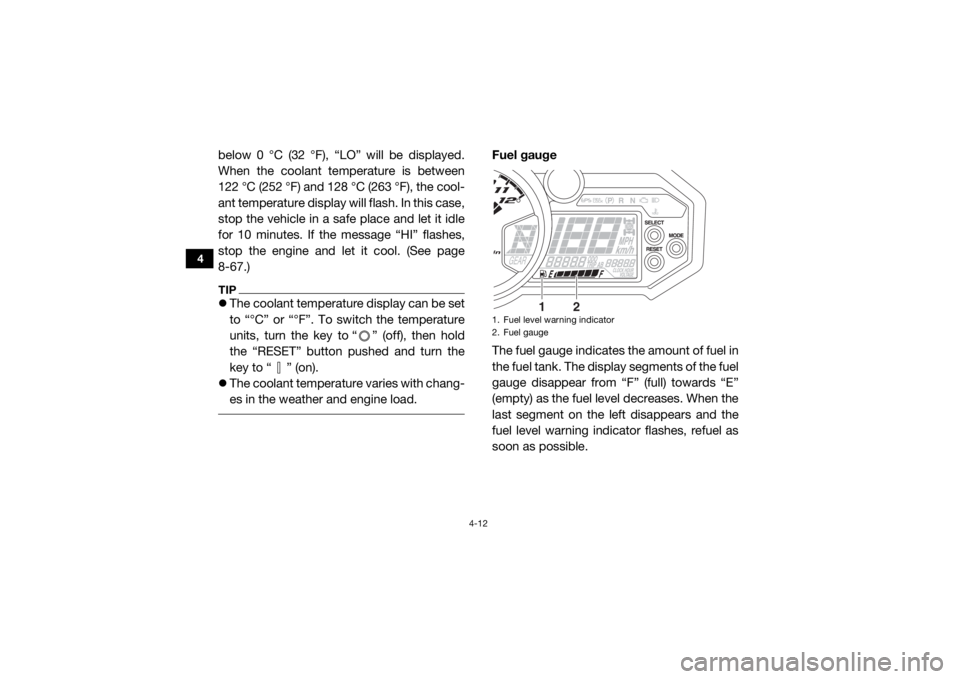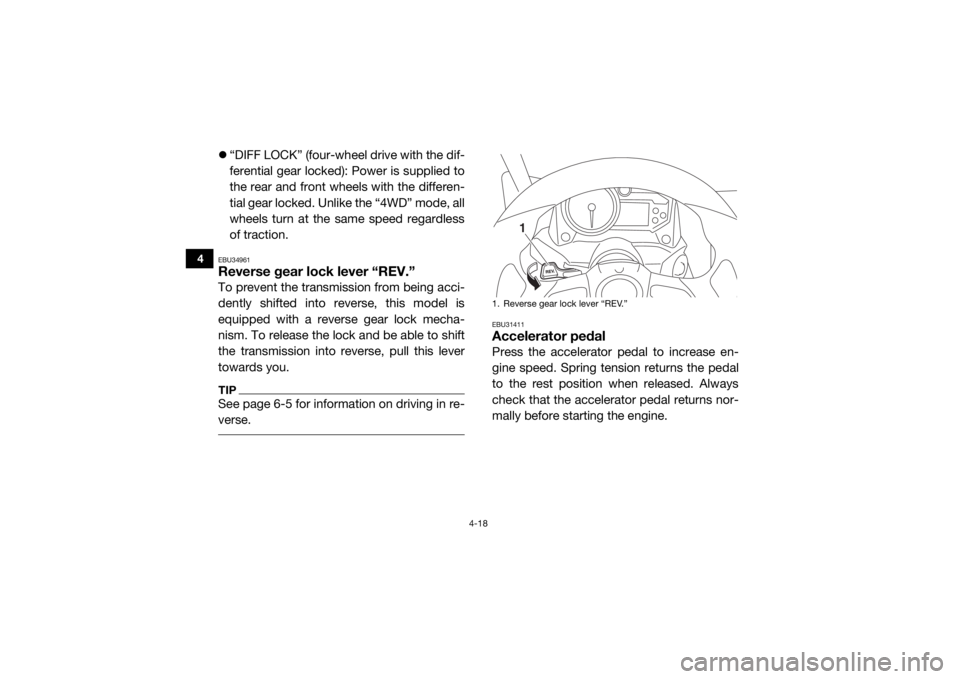tow YAMAHA YXZ1000R SS 2017 Owners Manual
[x] Cancel search | Manufacturer: YAMAHA, Model Year: 2017, Model line: YXZ1000R SS, Model: YAMAHA YXZ1000R SS 2017Pages: 208, PDF Size: 4.79 MB
Page 30 of 208

2-3
2
• Do not drive or ride as passenger after using drugs or alcohol.
Prepare your vehicle
Perform the pre-operation checks each time you use the vehicle to make sure it is in safe oper-
ating condition. Failure to inspect or maintain th e vehicle properly increases the possibility of an
accident or equipment damage. See page 5-1 for a list of pre-operation checks.
Prepare your load
Carrying heavy or over-sized loads can affect hand ling, stability, and cause the risk of overturns
or other accidents.
Read “Loading” on page 6-9 before loading the cargo bed.
Do not overload the vehicle or cargo bed.
Refer to the labels on the vehicle for specific loading limits and recommended tire air pressure.
Keep heavier objects and the load in general cent ered side to side, and as low and as far for-
ward in the cargo bed as possible.
Secure cargo so that it will not shift – a loose load could change handling unexpectedly or be
thrown forward and strike occupants.
This vehicle is not designed to tow or pull objects. Towing a trailer or pulling another vehicle or
other object will affect handling, stability, an d increase the risk of overturns and accidents.
Towing or pulling can also cause frame and vehicle damage.
U2HC7ME0.book Page 3 Tuesday, April 19, 2016 10:33 AM
Page 50 of 208

4-12
4
below 0 °C (32 °F), “LO” will be displayed.
When the coolant temperature is between
122 °C (252 °F) and 128 °C (263 °F), the cool-
ant temperature display will flash. In this case,
stop the vehicle in a safe place and let it idle
for 10 minutes. If the message “HI” flashes,
stop the engine and let it cool. (See page
8-67.)TIPThe coolant temperature display can be set
to “°C” or “°F”. To switch the temperature
units, turn the key to “ ” (off), then hold
the “RESET” button pushed and turn the
key to “ ” (on).
The coolant temperature varies with chang-
es in the weather and engine load.
Fuel gauge
The fuel gauge indicates the amount of fuel in
the fuel tank. The display segments of the fuel
gauge disappear from “F” (full) towards “E”
(empty) as the fuel level decreases. When the
last segment on the left disappears and the
fuel level warning indicator flashes, refuel as
soon as possible.1. Fuel level warning indicator
2. Fuel gauge
1
2
U2HC7ME0.book Page 12 Tuesday, April 19, 2016 10:33 AM
Page 56 of 208

4-18
4
“DIFF LOCK” (four-wheel drive with the dif-
ferential gear locked): Power is supplied to
the rear and front wheels with the differen-
tial gear locked. Unlike the “4WD” mode, all
wheels turn at the same speed regardless
of traction.EBU34961Reverse gear lock lever “REV.”To prevent the transmission from being acci-
dently shifted into reverse, this model is
equipped with a reverse gear lock mecha-
nism. To release the lock and be able to shift
the transmission into reverse, pull this lever
towards you.TIPSee page 6-5 for information on driving in re-
verse.
EBU31411Accelerator pedalPress the accelerator pedal to increase en-
gine speed. Spring tension returns the pedal
to the rest position when released. Always
check that the accelerator pedal returns nor-
mally before starting the engine.1. Reverse gear lock lever “REV.”
1
U2HC7ME0.book Page 18 Tuesday, April 19, 2016 10:33 AM
Page 104 of 208

6-9
6
EBU35440ParkingWhen parking, shift into first gear, stop the
engine, and then apply the parking brake. See
page 7-16 for when parking on a slope.EBU35351LoadingTake extra precautions when driving with a
load. Turn gradually and drive more slowly
than you would without a load. The more
weight you carry, the slower you should go.
Although conditions vary, it is good practice
to keep the vehicle in a low gear when you are
carrying a heavy load. Follow these instruc-
tions and always use common sense and
good judgment when carrying a load.
WARNING
EWB03921Improper loading or any pulling or towing
will increase the risk of loss of control, an
overturn, or other accident:
Do not pull objects, other vehicles, or
tow a trailer—this vehicle is not de-
signed for such operation.
Keep weight in the cargo bed centered
side to side, and as low and as far for-
ward as possible. Top-heavy loads in-
crease the risk of overturn.
Make sure that cargo is securely fas-
tened down—a loose load could change
handling unexpectedly or strike occu-
pants.
Do not exceed the maximum loading
limit for the cargo bed: 136.0 kg (300 lb).
Do not exceed the maximum loading
limit for the vehicle: 317.0 kg (699 lb).
Cargo bed
Use the hooks equipped on the cargo bed to
tie down loads. Make sure the load is securely
fastened down, centered in the cargo bed,
and not top-heavy. Never allow anyone to
ride in the cargo bed.
U2HC7ME0.book Page 9 Tuesday, April 19, 2016 10:33 AM
Page 194 of 208

9-1
9
EBU32720
CLEANING AND STORAGE
EBU35920CleaningFrequent, thorough cleaning of your vehicle
will not only enhance its appearance but will
improve its general performance and extend
the useful life of many components.1. Before cleaning the vehicle: a. Block off the end of the exhaust pipe to prevent water entry. A plastic bag
and strong rubber band may be used.
b. Make sure the spark plugs and all filler caps are properly installed.
2. If the engine case is excessively greasy, apply degreaser with a paint brush. Do
not apply degreaser to the wheel axles.
3. Rinse the dirt and degreaser off with a garden hose. Use only enough pressure
to do the job. WARNING! Test the
brakes after washing. Apply the
brakes several times at slow speeds to
let friction dry the brakes. Wet brakes may have reduced stopping ability, in-
creasing the chance of an accident.
[EWB03471]
NOTICE: Excessive water pres-
sure may cause water seepage and
deterioration of wheel bearings,
brakes, transmission seals and electri-
cal devices. Many expensive repair
bills have resulted from improper high-
pressure detergent applications such
as those available in coin-operated car
washers.
[ECB00712]
4. Once the majority of the dirt has been hosed off, wash all surfaces with warm
water and mild, detergent-type soap. An
old toothbrush or bottle brush is handy
for hard-to-get-at places.
5. Rinse the vehicle off immediately with
clean water and dry all surfaces with a
clean chamois towel or soft, absorbent
cloth.
6. Clean the seats with a vinyl upholstery cleaner to keep the covers pliable and
glossy.
U2HC7ME0.book Page 1 Tuesday, April 19, 2016 10:33 AM